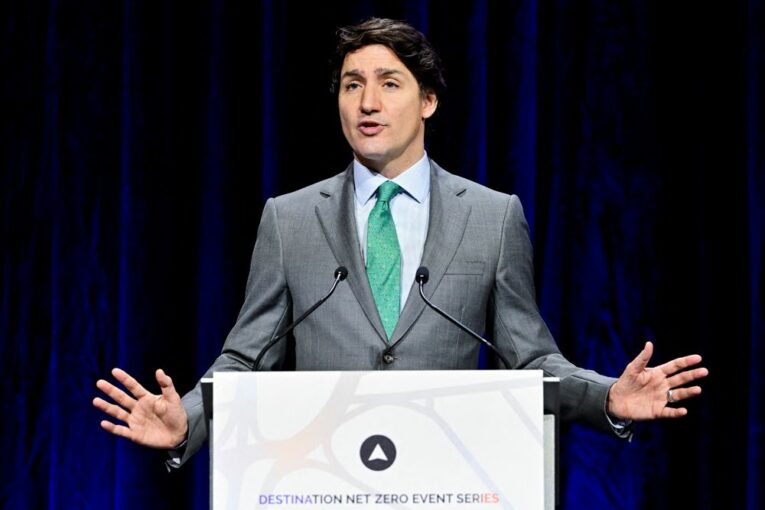
Prime Minister Justin Trudeau unveiled a plan that outlines how Canada will reduce emissions by about 45 per cent by 2030, telling an audience in Vancouver on March 29 that Canada’s approach to the climate crisis could not simply be “business as usual.”
The country will have to show more commitment to climate targets than it has to date. The federal energy regulator predicts that Canada is on track to increase oil production by 1.3 million barrels per day by 2030, which, all things equal, would put more carbon into the atmosphere. Although Canada has an innovative carbon pricing scheme, it has never been able to meaningfully reduce emissions. It is one of the largest largest emitters of greenhouse gasses when measured on a per capita basis.
“If we don’t do this now, it will be too late,” said Trudeau.
Tom Green, senior climate policy advisor at the Suzuki Foundation, an environmental group, said he is optimistic about the plan despite its implicit contradictions. “It’s much more of a comprehensive blueprint than we’ve had in the past,” he said. “The key thing is that this is actually a plan across all sectors and it sets targets, emission levels for different sectors, and then it explains how it’s going to bring them down.”
One of the country’s top business lobbies had a similar take.
“Canada’s business leaders fully support the goal of significantly reducing greenhouse gas (GHG) emissions by 2030, and this plan goes further than anything seen to date in spelling out how Canadians can get there,” Goldy Hyder, president of the Business Council of Canada, said in a statement.
Here are the highlights:
Carbon Pollution
The plan commits Canada to “offering lower carbon oil and gas to the world,” and cites the International Energy Agency, which has said that while there will be a steep decline in demand, oil production will continue for the foreseeable future.
Canada’s oilsands producers will be relieved by that language, as they argue that they’ve reduced emissions through innovation in recent years. Climate activists such as Green remain skeptical.
“Industry likes to talk about ethical oil, but in fact, Canada has one of the highest emissions intensity oil,” said Green. “We definitely shouldn’t be expanding Canadian oil production,” he added. “That is the really disappointing thing in the report.”
Green Communities … and Roads
Trudeau’s plan envisions “smarter,” greener communities.
It pledges to allocate $150 million to retrofit new buildings to make them greener, and $180 million will go to supporting climate initiatives led by First Nations, Métis, and Inuit organizations.
The plan will also make it easier for Canadians to go electric, with a $400 million investment in zero-emission vehicle (ZEV) charging stations, $500 million in ZEV charging and refueling infrastructure, and $1.7 billion to make it easier for Canadians to afford electric light-duty vehicles.
In just over a decade, gas-powered vehicles will be impossible to find. The plan sets out measures to ensure that 20 per cent of vehicle sales will be zero-emission as opposed to gas-powered by 2026, which will rise to 100 per cent by 2035.
Clean technology
The plan allocates $600 million to renewable energy and power-grid modernization, and another $250 million to support clean electricity projects. It commits to the development of a carbon capture strategy, where carbon is pulled from the atmosphere and buried underground.
Hyder said Canada’s biggest companies were prepared to spend “many billions” on clean technology, especially if policy is “predictable.” Environmentalists remain wary of technological solutions that could fail do deliver.
“We would have liked to see more being required of the oil and gas sector, and less reliance on unproven technologies like the carbon capture and storage,” said Green. He admitted, though, that the idea of pulling carbon directly from the atmosphere was attractive.
“Right now we definitely need it out of the atmosphere,” he said. “We’re seeing all of the extreme weather and we’re only at about a 1.1-degrees of temperature increase.”
Reality check
Though promising, the plan will almost certainly face challenges in implementation. Every time a new federal government is elected, the existing plan will be on the chopping block.
“This is going to be a big issue,” said Green. “And also getting the provinces on board.”
Green noted that when prices at the pump went up in response to Russia’s war on Ukraine, Alberta was quick to suspend its fuel tax, which is part of a vital component of Canada’s broader plan to get all provinces and territories to adhere to a common national price on pollution.
“The plan is definitely something that we can work with,” Green said. “But the key is going to be implementation. The plan is nothing if it’s not implemented.”
Something else on which the environmental and business lobbies agree.
“There are still a lot of unanswered questions ahead, and much heavy lifting,” Hyder said. “A close partnership between the public and private sectors will be critical in overcoming these challenges.”
• Email: [email protected] | Twitter: marisacoulton
You can read more of the news on source
